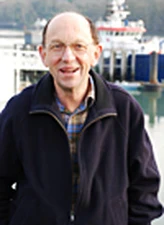John H. Simpson

The 2008 Fridtjof Nansen Medal is awarded to John H. Simpson for his outstanding contribution to understanding physical processes that govern shelf and shelf-edge processes and applying this to the benefit of multi-disciplinary studies of motion and life on the ocean’s shelves.
Professor John H Simpson’s early work on the spectra of surface waves led him to pioneering the development of ocean microstructure profilers and the application of electromagnetic current meters to study mixing in the ocean. His clear insight into physical processes led to his landmark paper on shelf fronts, Simpson and Hunter (1974). This paper has now been cited over 400 times. It predicted how the competition between tidal mixing and solar heating in the potential energy budget can determine the location of fronts in shallow seas and gave us the now famous Simpson-Hunter parameter h/u3. A multitude of papers have since used these ideas and methods to explain observed patterns of surface temperature and productivity around the world and the theoretical approach has provoked the development of a host of variants.
This led to fundamental work on estuarine fronts: The Simpson and Nunes (1981) paper exploited the theory of stratified hydraulic flows to interpret observations of the motion of a tidal intrusion front. Subsequently, Nunes and Simpson (1985) and Simpson and Turrell (1986) used the baroclinic pressure gradient-friction balance in across-channel momentum equation to explain novel observation of an axial convergence front. Only recently has technology developed sufficiently to allow more and better observations of these types of small-scale structures and Professor Simpson’s ground-breaking insights remain at the forefront of our thinking.
His work within coastal/shelf regions impacted by freshwater flows (e.g. eastern Irish Sea and the Rhine outflow), including identifying SIPS (representing shear induced periodic stratification) which is now part of the vocabulary of coastal oceanography students. This mechanism can result in significant estuary-ocean exchange and influence the vertical flux of nutrients. It is now a significant pillar of our understanding of vertical mixing in estuaries and the original article has been sited 118 times to date. His related papers on this topic are also frequently cited.
He has recently pioneered the study of turbulence in the shallow parts of the ocean, including the use of the microstructure profiler FLY to observe the tidal-scale evolution of the rate of turbulent kinetic energy dissipation (Simpson et al, 1996; 73 citations and still going strong) on the continental shelf. Using this data he led the first detailed evaluation of the dissipation rate predicted by the extensively used Mellor-Yamada boundary layer closure scheme on a tidal shelf. He and his research group has since followed this up with complementary ADCP derived measurements of the rate of turbulent kinetic energy production to more critically examine the effectiveness of turbulent closure schemes for coastal modelling (Buchard et al. 2002 and Rippeth et al, 2003).
His leadership and gentle advocacy at local, national and international forums has promoted very productive interdisciplinary and international collaborations. He has been a motivator and leading advocate for large interdisciplinary research programs like the NERC North Sea Program and the EU-MAST PROFILE and PROVESS projects, and the EU concerted action “CARTUM” that have illuminated the physical processes controlling shelf ecosystems both with funding agencies and less enlightened colleagues. He has also helped lead and administer them.
And finally he has taught hundreds of M.Sc. students and mentored almost 30 Ph.D.s. His students hold important posts in Universities and laboratories around the world. Despite apparently retiring last year he continues in research, extending his ideas into the Arctic and to SE Africa, along with writing a textbook on shelf sea physics and its impact on biological processes.
